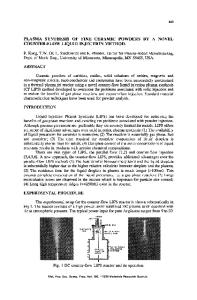Plasma Synthesis of Ceramic Powders
- PDF / 4,323,321 Bytes
- 6 Pages / 604.8 x 806.4 pts Page_size
- 119 Downloads / 418 Views
Plasma Synthesis of Ceramic Powders D.S. Phillips and G.J. Vogt Introduction Condensation from plasmas has been shown to yield very fine, high purity powders from even the most refractory materials. Elementary particles in these powders are often single crystals, as fine as 50 nm diameter. These particles vary widely in agglomeration state; in some systems they are essentially i n d e p e n d e n t , while in others hard agglomerates as large as several microns are observed. In this article the geometric aspects of reactor design which are thought to influence these powder structures are reviewed, along with three case studies in powder microstructure. Finally, the structure of the "typical" plasma powder is compared with expectations from alternative preparation routes. T h e d e v e l o p m e n t of n e w , e n e r g y efficient processing strategies for ceramic fabrication has become a rapid growth field over the last ten years. 1 " 4 Most of these strategies rely on minimizing diffusion r e q u i r e m e n t s d u r i n g densification by improving both the chemical homogeneity and the initial density of the powder compact to be consolidated; both requirements dictate unusual care in the synthesis of the starting p o w d e r s . In the oxide systems most extensively s t u d i e d to d a t e , the required powders can often be produced by precipitation from aqueous solutions and/or emulsions. 5 , 6 In the carbide and nitride systems widely envisaged for the next generation of structural applications, these techniques are difficult and gasphase synthesis routes appear more attractive. In fact, even the leading practitioners of the precipitation arts write enthusiastically of aerosol synthesis methods for the oxides. 7 High temperature gas-phase chemistry within plasma environments provides an alternative method for powder synthesis. This route is chemically nonspecific, since the t e m p e r a t u r e s typically accessible within the plasma (=7-10,000 K) allow the decomposition of near-arbitrary precursors. The p l a s m a r o u t e is e s s e n t i a l l y "containerless" since the powder particles form and cool entrained in a flowing gas stream, periodically meeting each other but seldom meeting the reactor walls. Moreover, the chemical supersaturations which provide the driving force for condensation of the particles can be large, leading to the production of very fine particles (typically 10 nm < r
Data Loading...











